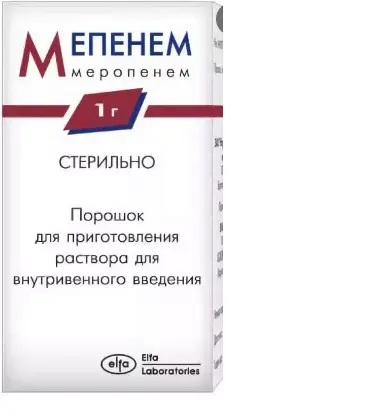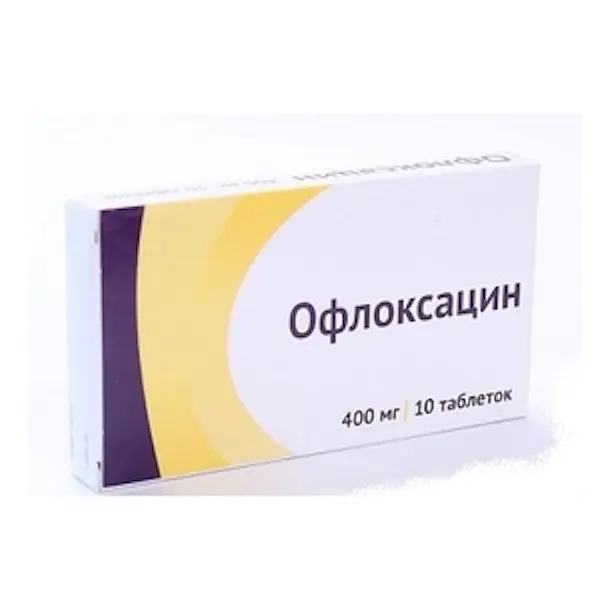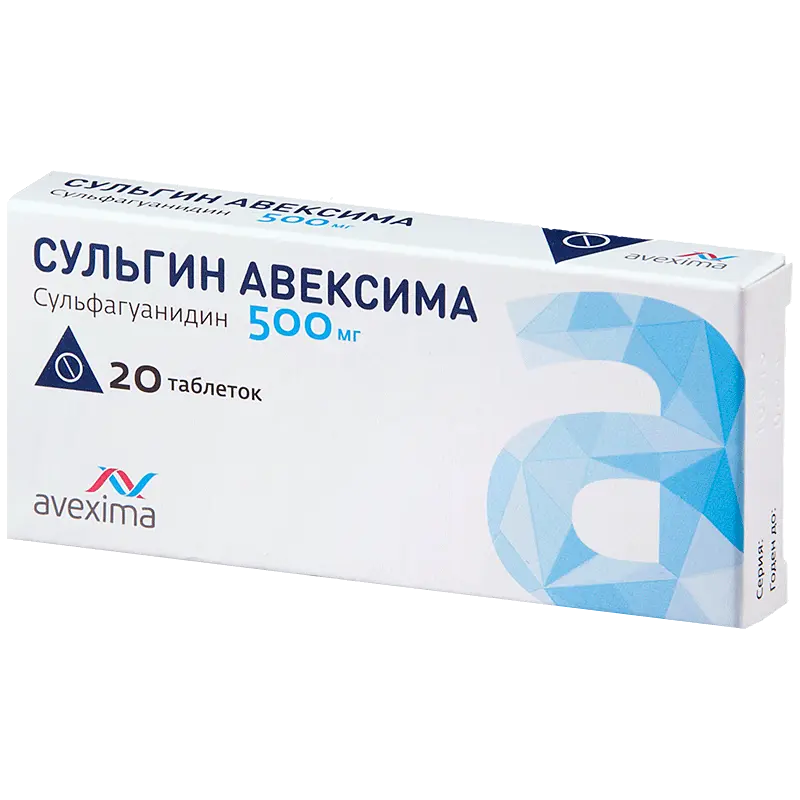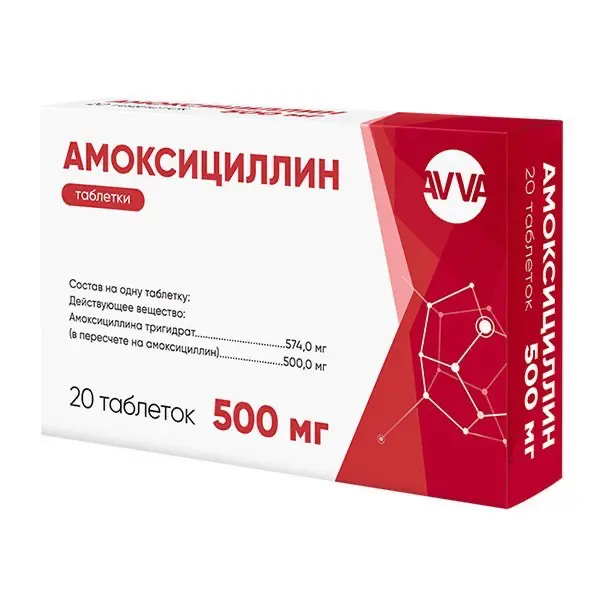Description
Mepenem Pharmacodynamics
Meropenem is an antibiotic of carbapenem group for parenteral use, it has a bactericidal effect. It interacts with the receptor specific penicillin-binding proteins on the surface of the cytoplasmic membrane, inhibits the synthesis of the peptidoglycan layer of the cell wall, inhibits transpeptidase, promotes the release of autolytic enzymes of the cell wall, which eventually causes its damage and death of the bacteria. It is resistant to the action of dehydropeptidase-1, easily penetrates through the bacterial cell wall, and is resistant to the action of most beta-lactamases. Among known beta-lactam antibiotics it has the highest activity against most aerobic and anaerobic gram-positive and gram-negative microorganisms.
Active in vitro and in vivo against:
Gram-positive aerobes: Enterococcus faecalis (excluding vancomycin-resistant strains), Staphylococcus aureus (methicillin-sensitive); Staphylococcus spp. including Staphylococcus epidermidis; Streptococcus agalactiae; Streptococcus pneumoniae; Streptococcus pyogenes, Streptococcus milleri group (Streptococcus anginosus, Streptococcus constellatus, Streptococcus intermedius).
Gram-negative aerobes: Citrobacter freundii, Citrobacter koseri, Enterobacter aerogenes, Enterobacter cloacae, Escherichia coli, Haemophilus influenzae, Klebsiella oxytoca, Klebsiella pneumoniae, Morganella morganii, Neisseria meningitidis, Proteus mirabilis, Proteus vulgaris, Serratia marcescens.
Gram-positive anaerobes: Clostridium perfringens, Peptoniphilus asaccharolyticus, Peptostreptococcus spp. including Peptostreptococcus anaerobius, Peptostreptococcus micros, Peptococcus magnus. Gram-negative anaerobes: Bacteroides caccae, Bacteroides fragilis, Prevotella bivia, Prevotella disiens.
Microorganisms for which acquired resistance is a problem: Gram-positive aerobes: Enterococcus faecium.
Gram-negative aerobes: Acinetobacter spp., Burkholderia cepacia, Pseudomonas aeruginosa.
Microorganisms with natural resistance: Stenotrophomonas maltophilia, Legionella spp., chlamydophila pneumoniae, Chlamydophila psittaci, Coxiella burnetti, Mycoplasma pneumoniae.
Indications
Infectious-inflammatory diseases caused by microorganisms sensitive to meropenem (monotherapy or in combination with other antimicrobial drugs): lower respiratory tract infections (pneumonia, including hospital pneumonia); intra-abdominal infections (complicated appendicitis, peritonitis); urinary tract infections (pyelonephritis, pyelitis); skin and soft tissue infections (including rust, impetigo, secondary infected dermatoses); bacterial meningitis; septicemia; pelvic infections (including endometritis, septicaemia). including rye, impetigo, secondary infected dermatoses); bacterial meningitis; septicemia; pelvic inflammatory diseases (including endometritis). Empirical treatment (as monotherapy or in combination with antiviral or antifungal agents) for suspected bacterial infection in adult patients with febrile episodes against a background of neutropenia.
Contraindications
Hypersensitivity to meropenem, other drug components and other carbapenems, marked hypersensitivity (anaphylactic reactions, severe skin reactions) to other beta-lactam antibiotics (i.e. penicillins or cephalosporins); childhood age (under 3 months).
Caution
Concomitant use with nephrotoxic drugs, patients with gastrointestinal complaints, especially colitis.
Use in pregnancy and during breastfeeding
The safety of meropenem administration in women during pregnancy has not been studied. The drug should not be used during pregnancy, except in cases when the potential benefit to the mother exceeds the possible risk to the fetus. B
In each case the drug should be used under close supervision of a physician. If it is necessary to use the drug during lactation, discontinuation of breastfeeding should be decided.
Dosage and administration method
- Intravenously by bolus for at least 5 minutes, or by intravenous infusion for 15 to 30 minutes.
- The dosage and duration of therapy should be determined according to the type and severity of the infection and the patient’s condition.
- The following daily doses are recommended:
- Adults
0.5 g intravenously every 8 hours in case of pneumonia, infections of the urinary system, infections of the small pelvis, infections of skin and soft tissue.
1 g intravenously every 8 hours in hospital pneumonia, peritonitis, suspected bacterial infection in patients with neutropenia, as well as septicemia. - In bacterial meningitis, the recommended dose is 2 g every 8 hours. In chronic renal insufficiency the dose is adjusted depending on creatinine clearance (CK): at CK of 26-50 ml/min – 0.5-1-2 g 2 times per day, 10-25 ml/min – 250-500-1000 mg 2 times per day, less than 10 ml/min – 250-500-1000 mg once per day.
- Meropenem is excreted by hemodialysis. If prolonged treatment is required, it is recommended that a unit dose (determined depending on the type and severity of the infection) be administered at the end of hemodialysis procedure to restore the effective plasma concentration. There are currently no data on the experience of meropenem administration in patients on peritoneal dialysis.
- No dose adjustment is required in patients with hepatic impairment.
Dose adjustment is not required in elderly patients with a CK of more than 50 ml/min. - Children
Recommended dose for intravenous administration in children aged 3 months to 12 years is 10-20 mg/kg of body weight every 8 hours depending on the type and severity of infection, sensitivity of pathogen and patient’s condition. In children with body weight over 50 kg, doses for adults should be used. - In meningitis the recommended dose is 40 mg/kg every 8 hours.
There is no experience of using the drug in children with hepatic and renal dysfunction. - Preparation of solutions
For intravenous bolus injections, meropenem should be diluted with sterile water for injection (10 ml per 500 mg of the drug). This provides a solution concentration of 50 mg/ml. For intravenous infusions meropenem is diluted with compatible infusion fluid
(50 to 200 ml). - Meropenem is compatible with the following infusion fluids:
– 0.9% sodium chloride solution;
– 5% or 10% dextrose solution;
– 5% dextrose solution with 0.02% sodium hydrogen carbonate;
– 0.9% sodium chloride solution and 5% dextrose solution;
– 5% dextrose solution with 0.225% sodium chloride solution;
– 5% dextrose solution with 0.15% potassium chloride solution;
– 2.5% and 10% mannitol solution. - Meropenem should not be mixed with solutions containing other drugs.
- For intravenous injections and infusions it is recommended to use freshly prepared meropenem solution.





